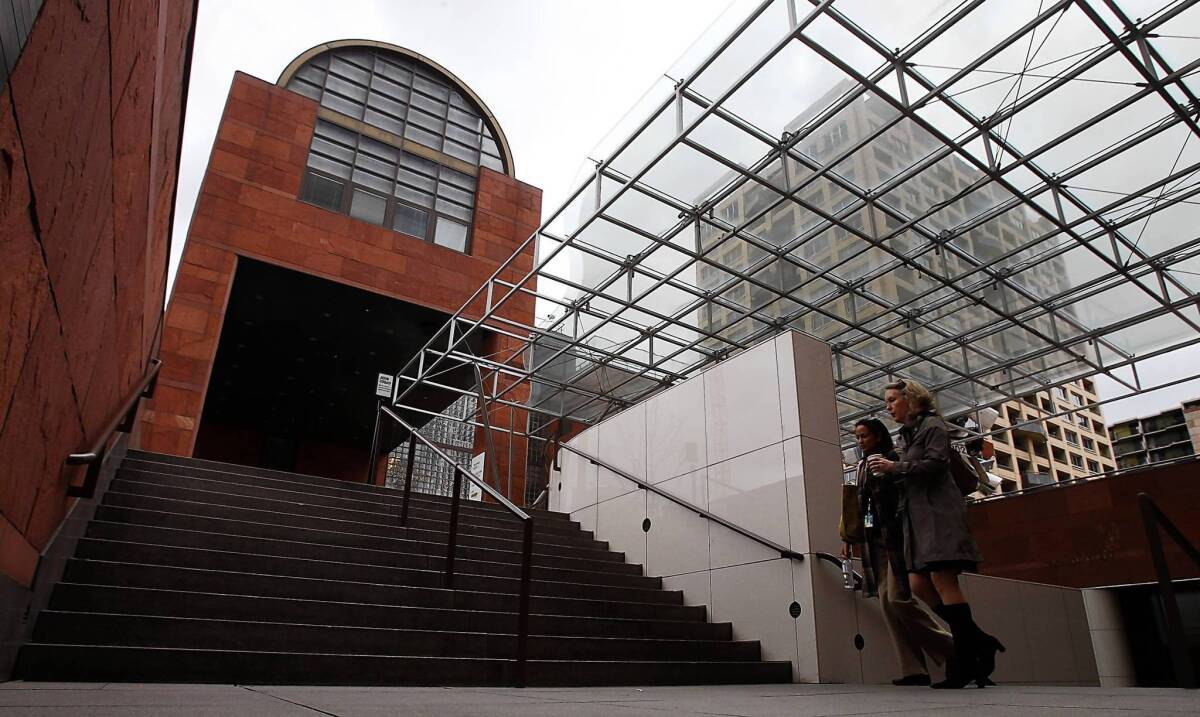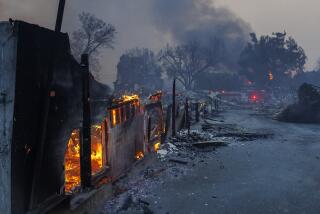MOCA board says museum will stay independent

- Share via
The trustees of L.A.’s Museum of Contemporary Art say they have decided not to turn over the keys to their financially ailing institution to others — notably the Los Angeles County Museum of Art — and will instead raise the money needed to keep the downtown museum independent.
The board issued a three-sentence statement Tuesday afternoon headlined “MOCA Trustees Committed to Independence.”
It gave no specifics — and did not refer directly to the lone option that has become public: an offer by LACMA and its director, Michael Govan, to acquire MOCA and raise $100 million as part of the takeover, while keeping the MOCA name and continuing to operate its two downtown buildings.
PHOTOS: Arts and Culture by The Times
“The board is in agreement that the best future for MOCA would be as an independent institution,” said the statement emailed by the museum’s spokeswoman. “The board understands that this will require a significant increase in MOCA’s endowment to ensure its strong financial standing. We are working quickly toward that goal.”
FOR THE RECORD:
MOCA board: In the March 20 Section A, an article about the decision by board members of the Museum of Contemporary Art to keep the institution independent said that Jeffrey Deitch had not worked in the nonprofit world before becoming MOCA director in 2010. He was a curator at the nonprofit deCordova Museum in Lincoln, Mass., before entering the commercial art world with CitiBank in 1979. —
The decision derails, at least for now, a proposed combination that leaders of LACMA hoped would attract major new gifts of art, because collectors tend to want their holdings to end up in the most prestigious institutions.
Govan issued a brief statement of his own: “Anything that will strengthen MOCA and maintain its commitment to contemporary art and to downtown Los Angeles is good for the art world and good for this city. We continue to offer our support for MOCA’s future, and look forward to seeing its vibrant program continue.” He had said that LACMA made its proposal in response to overtures from members of the MOCA board.
The MOCA trustees’ statement added that, in addition to committing to boost the endowment, the museum is “exploring all strategic options.”
What that means is unclear. USC had confirmed last December that it was talking to MOCA about an unspecified partnership, and recently John Wilmerding, chairman of the board of the National Gallery of Art in Washington, D.C., said an alliance that involved curatorial expertise but no money was in the works, instigated by MOCA’s leading funder, Eli Broad.
“The hope is that our name, our programming, our expertise gives them a sense of backbone and stability,” Wilmerding said last week. “Eli Broad is confident about this, that their trustees can raise the money, rebuild the endowment and bring it back to a place of fullness.”
FULL COVERAGE: 2013 Spring arts preview
Some art world observers have speculated that Broad is concerned about the effect LACMA’s acquisition of MOCA might have had on the launch of his Broad Collection museum, which is set to open across Grand Avenue from MOCA next year.
Broad declined to comment Tuesday, and other MOCA leaders, including the board’s co-chairs, David Johnson and Maria Bell, were not immediately available.
The swirl of offers and partnership talks again focused attention on the plight of MOCA, which laid off seven employees last summer, not counting three curators who’ve departed over the last 10 months, leaving the museum with just two remaining curators and a sparse list of scheduled exhibitions.
Broad had bailed out MOCA in December 2008, when years of overspending, compounded by that year’s global financial meltdown, had left it all but destitute.
Broad guaranteed $15 million over five years to help fund exhibitions, but one sign of MOCA’s continuing weakness, despite a board sprinkled with billionaires, was its failure to come up with matching funds for the rest of his bailout pledge — an additional $15 million for the endowment, contingent on matching gifts from other donors. MOCA had matched only $6.25 million, leaving $8.75 million on the table.
Broad’s attention may now turn to his own Broad Collection museum. Besides $130 million for construction, Broad, whose contemporary art collection is less than half as large as MOCA’s world-renowned, 6,000-piece trove of post-World War II art, has promised an endowment of at least $200 million intended to generate about $12 million a year, covering its projected operating expenses.
The MOCA board’s announcement generated both relief and skepticism.
“Does this mean the board is going to reach into their very deep pockets and write those very healthy checks? That would be nice,” said Catherine Opie, one of four well-known Los Angeles artists who resigned from the MOCA board last summer over frustration with the museum’s direction.
GRAPHIC: LACMA and MOCA at a glance
“I will be disappointed if MOCA is back in this place in two or five years,” Opie said, after having passed up what seemed to be a promising offer from LACMA and Govan.
Carol Schatz, president of the Central City Assn., a downtown business owners’ group, applauded the MOCA board’s decision to remain independent. “It’s critical because they’re such an important stakeholder downtown,” with the potential to become a bigger attraction in synergy with the Broad Collection.
Schatz said that she was wary about MOCA being subsumed into LACMA, whose seven-building campus, plus an eighth one designated for a new motion picture museum, is on Wilshire Boulevard’s Miracle Mile. “What’s to prevent them from saying under a merger scenario that it’s more economical for us if it goes to Wilshire?”
Cindy Bernard, an artist and co-founder of MOCA Mobilization, a grass-roots support and watchdog group launched during MOCA’s previous crisis in late 2008, applauded the board’s decision to keep MOCA independent. “I think the arts community in Los Angeles is best served by the kind of diversity that an independent MOCA represents; more voices is always better than fewer voices,” she said.
But, like Opie, Bernard said it’s now incumbent on the MOCA board to show that it’s truly committed to funding the museum and seeing that it’s ably governed.
“I think the $100 million mentioned by LACMA sort of sets a bar that the board probably needs to meet to ensure some longtime viability of the museum,” Bernard said. “The oligarchs on the board need to step up and support the museum, or get off the board.”
Another task for the board is restoring public confidence, Bernard said.
“They’re really going to have to work to create a sense of belief in the city to support the museum,” she said. “They’re going to have to make the right choices.”
Bernard said she hoped the board would hire leaders who are proven institution builders and fundraisers. Jeffrey Deitch, the New York City art dealer chosen as MOCA director in 2010, hadn’t worked in the nonprofit world, where fundraising is a priority, before he came to the museum.
MORE
INTERACTIVE: Christopher Hawthorne’s On the Boulevards
Depictions of violence in theater and more
PHOTOS: Arts and culture in pictures
More to Read
The biggest entertainment stories
Get our big stories about Hollywood, film, television, music, arts, culture and more right in your inbox as soon as they publish.
You may occasionally receive promotional content from the Los Angeles Times.











